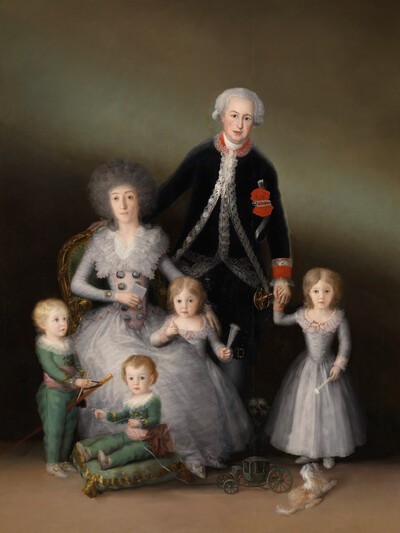- Cronología
- 1816
- Ubicación
- The Prado National Museum. Madrid, Madrid, Spain
- Dimensiones
- 92 x 70 cm
- Técnica y soporte
- Oil on canvas
- Reconocimiento de la autoría de Goya
- Documented work
- Titular
- El Prado National Museum
- Ficha: realización/revisión
- 12 Apr 2010 / 13 Jun 2023
- Inventario
- (P07713)
- Otros títulos:
-
The Duchess of Abrantes (La duquesa de Abrantes)
D.ña Manuela Giron y Pimentel / Duq.sa de Abrantes. // P.r Goya. 1816 ("Doña Manuela Girón y Pimentel, Duchess of Abrantes. By Goya. 1816", on the musical score in the sitter's hand).
This portrait was commissioned by the subject's mother as a gift to her daughter. Goya was paid 4,000 reales for his work.
The painting was in the collection of the Duke of Abrantes, later entering that of the Count of La Quinta de la Enjarada, then that of the Count of El Valle de Orizaba, and later passing to his descendants. In 1996 it was acquired using funds from the Villaescusa bequest, to be displayed in the Prado Museum.
Manuela Isidra Téllez Girón y Alonso Pimentel (Madrid, 1794-1838) was the daughter of the Duke and Duchess of Osuna. Goya maintained a close relationship with the Osuna family and had painted them previously, all together in the 1788 work The Family of the Duke of Osuna as well as in other, individual portraits, such as The Marchioness of Santa Cruz and The Tenth Duke of Osuna, both works depicting siblings of the woman in this portrait. In 1813 she married Ángel María de Carvajal, VIII Duke of Abrantes.
The half-length portrait shows the Duchess of Abrantes in front of a plain dark background, dressed in the French style that had established itself after the return of Ferdinand VII to Spain. The blue dress is covered with a yellow shawl. She wears matching necklace, bracelet and earrings, all made from crystal beads, and a floral diadem around her curly hair, with her shoulders left uncovered. Her rosy face presents a pair of carmine lips. She is looking shyly out at the viewer. In her right hand the sitter holds a sheet of music - which Goya has used to insert his signature - alluding to her fondness for singing. It was also fairly common back then to paint women with references to music.
The portrait has a neoclassical appearance - ordered and serene. It is in the details that Goya's mastery shows through, such as the treatment of the jewels, the flowers in the sitter's hair, and even the musical notes on the paper. The execution is freer in the clothing and in the lace around the neckline. The bolder colour palette used in this work is particularly interesting, with its golden shawl, blue dress and green and white flowers. This is one of the last aristocratic portraits that Goya made before dedicating himself to painting his friends and close acquaintances in a series of paintings with darker tones and very straightforward compositions.
-
Goya 1900Ministerio de Instrucción Pública and Bellas ArtesMadrid1900consultant editors Aureliano de Beruete, Alejandro Ferrant, Marqués de Pidal and Ricardo Velázquez. May 1900cat. 10
-
Pintura española de la primera mitad del siglo XIXSociedad Española de Amigos del ArteMadrid1913cat. 148
-
Retratos de mujeres españolas por artistas españoles anteriores a 1850Sociedad Española de Amigos del ArteMadrid1918cat. 35
-
Pinturas de GoyaMuseo Nacional del PradoMadrid1928consultant editor Fernando Álvarez de Sotomayor. From Apri to -May 1928cat. 15
-
Francisco de Goya. IV Centenario de la capitalidadorganized by Ayuntamiento de Madrid and Dirección General de Bellas Artes at the Casón del Buen RetiroMadrid1961consultant editor Valentín de Sambriciocat. XXXI
-
Goya en las colecciones madrileñasMuseo Nacional del PradoMadrid1983consultant editor Enrique Lafuente Ferrari. From April 19th to June 20th 1983cat. 49
-
Goya nelle collezioni private di SpagneVilla FavoritaLugano1986consultant editor Marta Medina. From June 15th to October 15th 1986cat. 45
-
Goya (1746 – 1828)Galleria Internazionale d’Arte Moderna di Ca’PesaroVenecia1989consultant editor Antonio Fortún Paesa. From May 7th to July 4th 1989cat. 50
-
GoyaLa Lonja, Torreón Fortea y Museo Pablo GargalloZaragoza1992consultant editor Julián Gállegocat. 52
-
Goya en las colecciones españolasSala de Exposiciones del BBVAMadrid1995consultant editor Juan J. Luna. From December 14th 1995 to February 17th 1996cat. 44
-
De Tiziano a Goya. Obras maestras del Museo del PradoTokio Metropolitan Art MuseumTokyo2006from March 25th to June 30th 2006. Exhibitied also at the Municipal Museum of Art, Osaka, July 15th to October 15th 2006, consultant editor Juan J. Luna
-
Goya en tiempos de guerraMuseo Nacional del PradoMadrid2008consultant editor Manuela B. Mena Marqués, from April 14th to July 13th 2008cat. 169
-
Goya luces y sombrasCaixaForumBarcelona2012consultant editors José Manuel Matilla and Manuela B. Marqués. From March 16th to June 24th 2012cat. 46
-
L'œuvre peint de Goya. 4 volsParís1928-1950vol. II, p. 209, cat. 498
-
Vie et ouvre de Francisco de GoyaParísOffice du livre1970pp. 298, 377, cat. 1560
-
BarcelonaPolígrafa1970vol. I, p. 366, cat. 650
-
L’opera pittorica completa di GoyaMilanRizzoli1974p. 130, cat. 604
-
Francisco de Goya, 4 vols.ZaragozaCaja de Ahorros de Zaragoza, Aragón y Rioja1980-1982vol. IV. p. 67
-
Goya y el espíritu de la IlustraciónMadridMuseo del Prado1988p. 136, cat. 52 y p. 137 (il.)
-
Goya en tiempos de guerraMadridMuseo Nacional del Prado2008p. 462, cat. 169 y p. 463 (il.)


